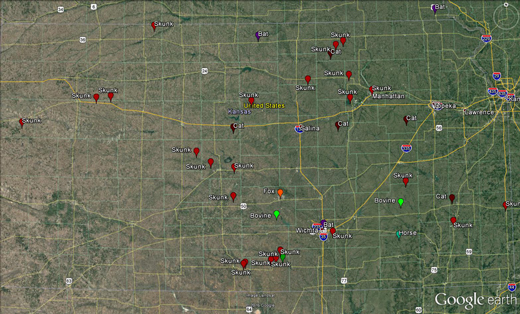Kansas State University veterinarian offers prevention tips following recent rabies case in area
Friday, July 15, 2016

This map shows the locations of rabies positive animals found in Kansas in the past six months, including a cat in Wabaunsee County in late June. | Download this photo.
MANHATTAN — With the recent diagnosis by the Kansas State University Rabies Laboratory of a rabies positive cat from Wabaunsee County, a university veterinarian recommends several steps to limit exposure of the disease to humans and animals.
Susan Nelson, veterinarian and clinical associate professor at the university's Veterinary Health Center, said any mammal can get rabies, but most cases occur in wild animals — primarily raccoons, bats, skunks, coyotes and foxes. Many cases of rabies occur in dogs and cattle, and to a lesser extent in horses, goats, sheep, swine and ferrets. Birds, fish, reptiles and amphibians do not get rabies, Nelson said.
"The virus is secreted in saliva and is usually transmitted to people and animals by a bite from an infected animal," Nelson said. "Rabies also can be transmitted when saliva from a rabid animal comes in contact with an open cut on the skin or mucous membranes of the eyes, nose or mouth of a person or animal. Rare cases of rabies have been spread via corneal or organ/tissue transplants from an infected donor."
Nelson says following these eight tips can help minimize rabies exposure in pets and people:
• Dogs, cats, ferrets, horses and select livestock should be vaccinated against rabies as recommended by your veterinarian. Licensed vaccines are available for these species, as well as for cattle and sheep.
• Keep your pet up-to-date on its rabies vaccine. This greatly reduces the chances of developing rabies and makes postexposure management much less of a headache — and less expensive — for you.
• Do not allow your pets to roam free.
• Don't keep wild animals as pets.
• Don't leave uneaten pet food outside and keep garbage cans covered to reduce the attraction of wild and stray animals.
• Never try to touch stray or wild animals. Children should never try to pet an unfamiliar animal, even if it looks friendly.
• Bat-proof your home.
• Report any wild or stray animal that is acting strangely to your local animal control.
Symptoms of rabies are variable and are caused by effects of the virus on the nervous system and brain. Nelson said these following common symptoms often occur in dogs, cats and ferrets: fearfulness, aggression, excessive drooling, difficulty swallowing, staggering and seizures. Infected horses, cattle, sheep and goats also may act depressed, have increased sensitivity to light or may self-mutilate themselves. She notes, however, that any of these symptoms can occur in any of these species.
"Wild animals with rabies may only display unusual behavior, such as wandering in the daytime when they are normally only out at night or uncharacteristically approaching humans," Nelson said. "Once symptoms develop, death almost always follows shortly thereafter."
If a stray or wild animal bites your pet, Nelson advises visiting your veterinarian as soon as possible — ideally within 96 hours — for advice and medical management. If a person is bitten, immediately wash the wound with soap and water and contact their physician for further advice.
"In both cases, if the biting animal is known and owned, the owner should be contacted to determine its rabies vaccine status. This also will help determine if your pet needs a rabies booster," Nelson said. "If it is a stray or wild animal, contact local animal control with a description of the animal to see if it can be caught and submitted for rabies testing."
If you have to catch the animal for testing yourself, always wear gloves and try to capture it without touching it — and only if it can be done safely.
While the number of human rabies cases in the U.S. is very rare, Nelson says more recent cases are from exposure to rabid bats.
"Remember to never release a bat that is found in a room with your pet, a sleeping person, a young child, an intoxicated person or a person of diminished mental capacity," Nelson said. "It should be captured and submitted for rabies testing as all these scenarios are considered exposure to the bat, regardless if small bite wounds are found or not."
For more information, contact the Kansas State University Veterinary Health Center at 785-532-5690 or vhc@vet.k-state.edu.
